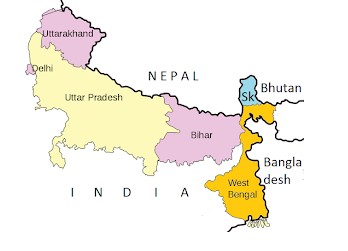OVERVIEW OF THE INDIA-NEPAL BORDER DISPUTE The India-Nepal border issue primarily revolves around the Kalapani-Limpiadhura-Lipulekh trijunction, where the borders of India, Nepal, and China meet. This dispute has deep historical roots that date back to the early 19th century during the British colonial rule in India and the Kingdom of Nepal. The Treaty of Sugauli (1816) - The Treaty of Sugauli was signed in 1816 following the Anglo-Nepalese War (1814-1816). Under this treaty, Nepal lost significant territories to the British East India Company, including the areas west of the River Kali. The treaty stipulated that the Kali River would demarcate the boundary between India and Nepal, but differing interpretations and subsequent maps have caused disagreements over its precise course.
The Shift in River Course and Maps - Multiple British-era maps have shown varying origins and courses for the Kali River. Maps from 1819, 1821, 1827, and 1856 indicate the river starting at Limpiadhura, but a map in 1879 introduced a different stream as the Kali, complicating the issue. The last British map in 1947 reverted to showing the Kali originating from Limpiadhura, supporting Nepal's claims based on historical cartographic evidence.
Modern Developments - In recent years, the dispute has intensified with Nepal's new map in 2020 including the disputed territories, which was followed by the decision to place this map on the Nepalese Rs 100 currency note in 2023. This move has been termed as "cartographic aggression" by India, which insists on solving the issue through diplomatic channels based on historical evidence and agreements.
Strategic Significance - The disputed area's strategic importance is underscored by its location near the India-China border, making it significant for India's security, especially following the Indo-China war of 1962. Nepal, under King Mahendra, had permitted India to use the area for defense purposes, a point of contention in later years.
Recent Bilateral Talks - Despite several high-level discussions and agreements to resolve the dispute diplomatically — including promises from Indian leaders like I.K. Gujral and Atal Bihari Vajpayee to reconsider the territorial claims if presented with evidence — little progress has been made. The issue remains a point of friction in bilateral relations, exacerbated by events like the economic blockade of Nepal by India in 2015, and Nepal's subsequent outreach to China for economic partnership and border security agreements.
Differing Perspectives - British India's surveys in the 1870s depicted Kalapani as part of India on a 1879 map. The Indian government asserts that this map should define the India-Nepal border, rather than earlier maps cited by Nepal. While Nepal bases its claim on historical maps and treaties, India’s stance has been influenced by strategic needs and administrative control since the mid-20th century. The absence of clear, unambiguous historical evidence and the shifting courses of natural landmarks like rivers have further complicated the resolution process.
|
